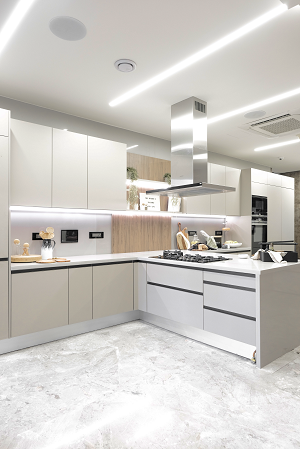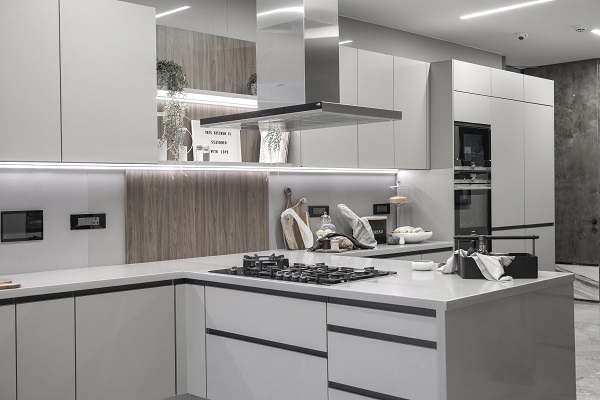The kitchen is where you spend most of your time. Hence, the more efficiently it works, the better it is for you, saving up on effort and time. Having things handy and in designated spots, while keeping appliances accessible and denoting dry and wet spaces in a kitchen is essential, but just the tip of the iceberg. With time, spaces have evolved with more modern ideas and technological retrofits of the same. Modern-day products are not just about aesthetics but have extensions and plugins that connect one appliance to another- to time out your food or even take care of heating and refrigeration. Such connected kitchens can improve how you approach your daily routine and make life easier when it comes to cooking your meals. Here’s what Designer Monica Chawla, Principal at Essentia Environments, likes about some of the trending and up-and-coming technologies occupying your kitchen spaces.
Smart Appliances
From our learnings of the pandemic, there has been a noticeable change in the lifestyle of a
regular Indian family. With house help becoming scarce due to the lockdown and other safety protocols, working women and singles needed to rely on technology to keep up with their daily activities. Gone are the days of spending hours in the kitchen. More and more people these days are starting to take advantage of wifi-enabled appliances such as hotpots, air fryers, self-stirrers, self-precision cookers, and so on. All these amenities help us in our hectic fast-paced lives. An example of smart appliances is the Internet of Things (IoT) – which refers to devices connected over the internet with sensors and emitters that send information back and forth between them via wireless signals. IoT devices range from simple sensors such as weather monitors to more complex communication systems like those used by factories or hospitals; they’re often referred to as “smart” because they offer convenience through automated functions that make life easier or safer.”

The Plugging Situation
The next time you’re designing a kitchen, think about incorporating drawers with charging stations. Apart from storing your dry items and keeping them at bay from pests, these storage spaces also have the added benefit of charging your phone or tablet when it’s plugged into one of their USB ports. Another way to keep your gadgets charged while they’re stored away is by adding wireless charging pads, available in various sizes so that they’ll fit most kitchens’ space restrictions (or lack thereof). Wireless chargers don’t require cords or outlets; instead, they communicate with each other via radio waves so that you can place them anywhere without worrying about getting tangled up in wires!
Touchless fixtures
Touchless faucets, also known as hands-free faucets, are faucets that use sensors to activate
the flow of water without the need for physical touch. They use infrared sensors to detect the presence of hands, so the faucet will automatically turn on when you place your hands under the spout. Some faucets also have a manual override that allows you to turn the water on and off manually. Apart from being convenient to use, these faucets not only help reduce the spread of germs and bacteria because they don’t require you to physically touch the faucet to turn it on, but they also reduce water waste by automatically shutting off after a set period of time, and some models also have adjustable flow rates to conserve water.
Monica Chawla, Principal at Essentia Environments
AI meets kitchen
Artificial intelligence (AI) has the potential to revolutionize the kitchen and cooking. Here are some of the ways AI is currently being used in kitchens:
- Recipe recommendation: AI algorithms can analyze recipe ingredients and suggest new recipes based on ingredients on hand or dietary restrictions.
- Smart cooking: AI-powered kitchen appliances can help with meal planning, ingredient shopping, and cooking. For example, smart ovens can recognize the food you put inside and automatically adjust the cooking time and temperature.
- Food safety: AI-powered sensors and cameras can monitor food temperature and expiration dates, reducing the risk of foodborne illness.
- Food waste reduction: AI can help optimize grocery shopping and meal planning to reduce food waste. For example, an AI-powered refrigerator can keep track of what food is stored inside and suggest meals based on the ingredients that are about to expire.
- Personalized nutrition: AI can analyze dietary information, food preferences, and health data to suggest personalized meal plans and recipes.
- Virtual bartenders: AI-powered bartending machines can make custom cocktails based on personal preferences, using information about ingredients and recipes stored in their databases.
As technology advances, it’s likely that AI will become even more integrated into our kitchens and cooking. If you’re an interior designer or an architect designing for future generations, you’ve probably heard that kitchens are the new living rooms. With that in mind, you should consider incorporating technologies into your design projects to make life easier for your clients and yourself.


